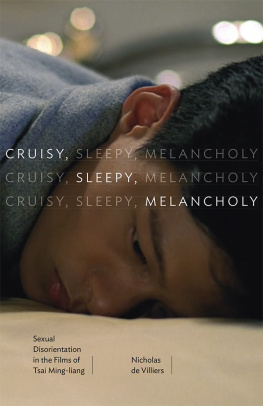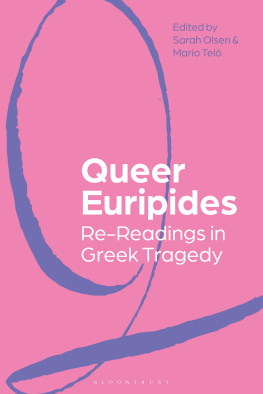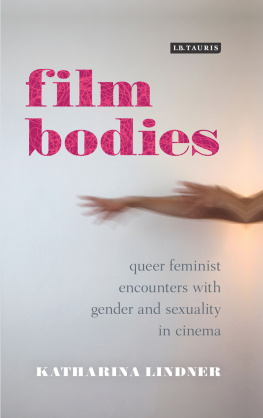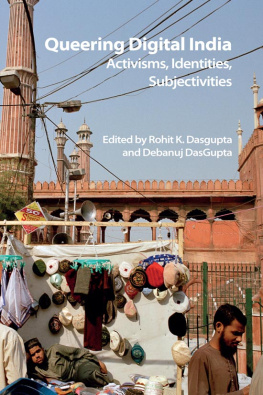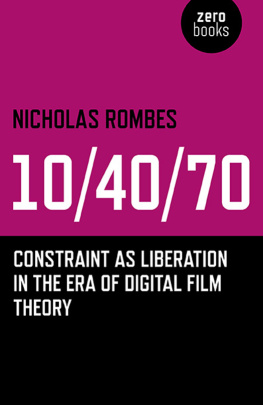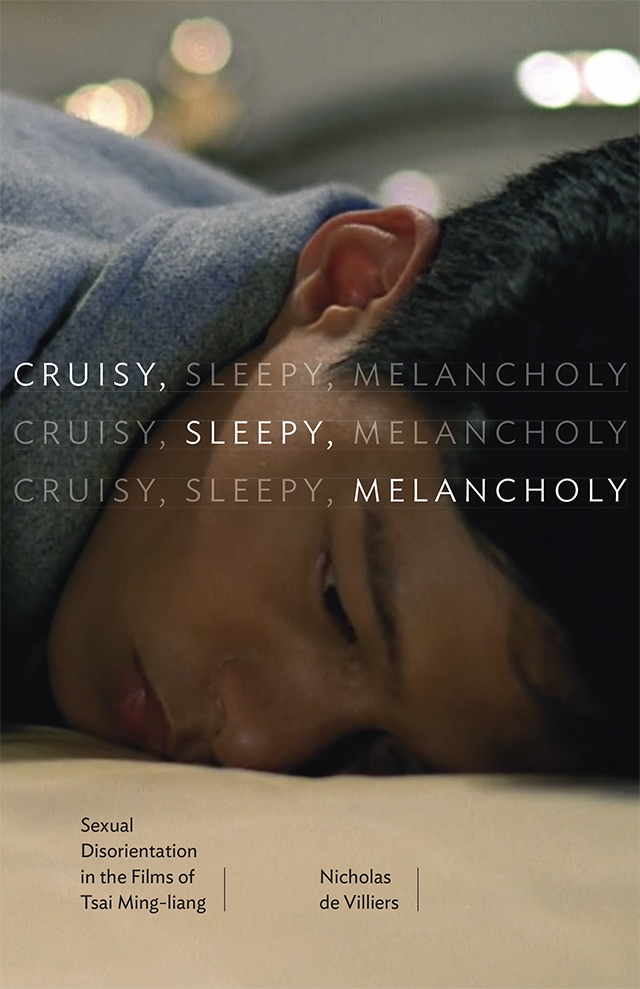
Cruisy, Sleepy, Melancholy
Cruisy, Sleepy, Melancholy
Sexual Disorientation in the Films of Tsai Ming-liang
Nicholas de Villiers

University of Minnesota Press
Minneapolis London
The University of Minnesota Press gratefully acknowledges the financial assistance provided for the publication of this book by the University of North Florida.
Cover design by Adrianna Sutton
Cover image: Vive LAmour (Tsai Ming-liang, 1994). Copyright Central Motion Picture Corporation.
Chapter 1 was originally published as Spatial and Sexual Disorientation in the Films of Tsai Ming-liang, IAFOR Journal of Literature & Librarianship 2, no. 1 (2013), https://doi.org/10.22492/ijl.2.1.05. Chapter 2 was originally published as Leaving the Cinema: Metacinematic Cruising in Tsai Ming-liangs Goodbye, Dragon Inn,Jump Cut 50 (Spring 2008), https://www.ejumpcut.org/archive/jc50.2008/DragonInn/.
Copyright 2022 by the Regents of the University of Minnesota
All rights reserved. No part of this publication may be reproduced, stored in a retrieval system, or transmitted, in any form or by any means, electronic, mechanical, photocopying, recording, or otherwise, without the prior written permission of the publisher.
Published by the University of Minnesota Press
111 Third Avenue South, Suite 290
Minneapolis, MN 55401-2520
http://www.upress.umn.edu
ISBN 978-1-4529-6780-6 (ebook)
A Cataloging-in-Publication record for this book is available from the Library of Congress.
The University of Minnesota is an equal-opportunity educator and employer.
Perhaps the immobility of the things that surround us is forced upon them by our conviction that they are themselves, and not anything else, and by the immobility of our conceptions of them. For it always happened that when I awoke like this, and my mind struggled in an unsuccessful attempt to discover where I was, everything would be moving round me through the darkness: things, places, years. My body, still too heavy with sleep to move, would make an effort to construe the form which its tiredness took as an orientation of its various members, so as to induce from that where the wall lay and the furniture stood, to piece together and to give a name to the house in which it must be living.
M ARCEL P ROUST , Swanns Way
Contents
Queer Metacinema
Its a Dream
The work in the mirror and the work in the seed have always accompanied art without ever exhausting it.... By the same token, the film within the film does not signal an end of history, and is no more self-sufficient than is the flashback or the dream: it is just a method of working.
Gilles Deleuze, Cinema 2: The Time-Image
As we see, what passes into the work is certainly the authors life, but a life disoriented.
Roland Barthes, Longtemps, je me suis couch de bonne heure
Tsai Ming-liangs short film Its a Dream (2007) contains in nucleo his understanding of cinema as a dreamlike state and his reflection on the cinema as a space so saturated with memory and cruisy queer desire that it can feel disorienting. A temporally disorienting autobiographical voice-over opens the film: I dreamt of my father as a young man. He woke me in the middle of the night. We ate durians together. My mother was there too. She was already an old lady.
Tsais voice-overlike Marcel Prousts narratorsuggests that what passes into this work is the authors life, but a life disoriented by time, by Tsais queer kinship with his cinematic muse, and by the affectively charged space of the cinema.
An old-fashioned Mandarin pop song from the 1940s plays over the remainder of the shots from Its a Dream, all of which feature characters facing toward an unseen movie screen, leading us to speculate as to whether it might be diegetic sound (the soundtrack of the film they are watching but which we cannot see). The song features melancholy and philosophical lyrics:
Last night, the moon was pale and mesmerizing
Even the pine forest held its breath
I thought of you in my dream
My mind was caught between sadness and joy
Tonight, the moon is bright like a mirror
As we stroll together under the bridge
Let me ask you in my dream
Is this a dream or reality?
While this song plays, we see actors who appeared (but did not meet onscreen) in Tsais first feature film to be set in Malaysia, I Dont Want to Sleep Alone (2006): we observe a woman (Pearlly Chua) eating pears on a skewer and then, without turning her head, she reaches the skewer back to the row behind her to share the sliced pears with a man (Norman bin Atun), who takes a bite between puffs on a cigarette. Picking up the cigarette motif, we see a shot of Lee Kang-sheng lighting a cigarette, with the boy seated next to him snacking from a paper packet. The final shot features only the family members, including the portrait of the maternal grandmother, seated together in one row, facing the screen, in an otherwise seemingly empty theater (Figure 1). The film acts as a kind of mirror for contemplating film spectatorship (and Tsais own past), caught between sadness and joy.
Its a Dream condenses many of the central themes and motifs of Tsais entire body of work: melancholy, nostalgia, familial intimacy, cruising, dreaming, and both temporal and spatial disorientation. It juxtaposes discontinuous generational time (including the afterlife and the temporal distortion of age in dreams) with apparently continuous screen time, and employs shifting spatial continuity in a nonetheless surreal location that acts as a kind of heterotopia. What I am calling queer metacinema holds up a mirror to the cinema and its audience, but can also act like a seed encapsulating the queer potentiality of this space.
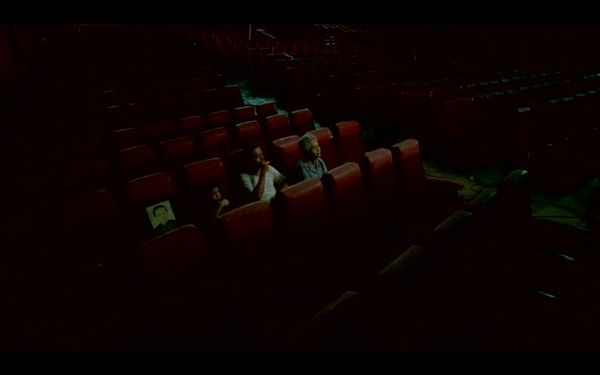
Figure 1. Its a Dream (Tsai Ming-liang, 2007). Is this a dream or reality? The cast seated in the dark, mostly empty movie theater represent Tsais cinephile maternal grandmother (in a photograph), himself as a child, his male muse Lee Kang-sheng as his father, and his actual mother.
Tsai provocatively mixes the familial scene of relatives with the erotic cruising of strangers in the movie theater (recalling the provocative mixture of anonymous bathhouse cruising and filial relations in his early film The River [1997]). The pears on the skewer nostalgically reference the food enjoyed with his maternal grandmother, but the durian is even more evocative as a notoriously culturally specific food (prohibited from certain enclosed places due to its pungent aroma, but also a marker of connoisseurship in Malaysia).
Its a Dream overlays motifs from I Dont Want to Sleep Alone, his film about spatial and sexual disorientation set in Malaysias capital, Kuala Lumpur (the subject of chapter 1) and Tsais metacinematic film Goodbye, Dragon Inn (2003), a melancholy ode to a cruisy old Taipei movie theater at its last screening (the subject of chapter 2). In an interview, Tsai explained how with Goodbye, Dragon Inn, I feel like it was the theater that was calling me to make the film. That theater reminded me of my experience growing up in Malaysia. At that time there were seven or eight grand theaters like that, that have disappeared one by one over the past few years. Prior to making
Next page
